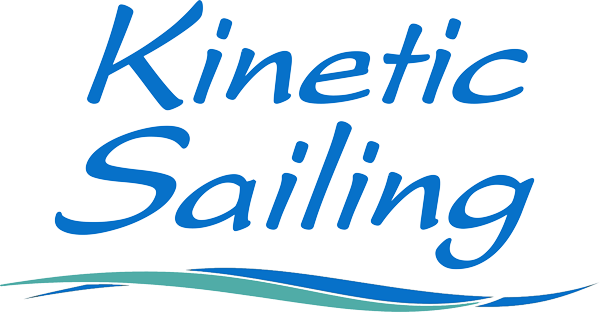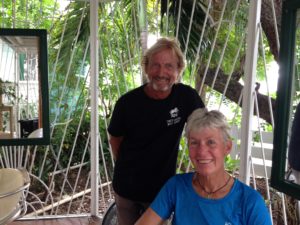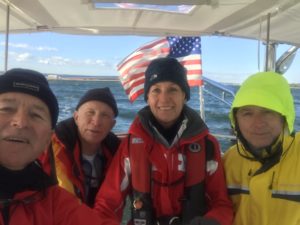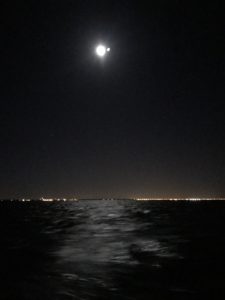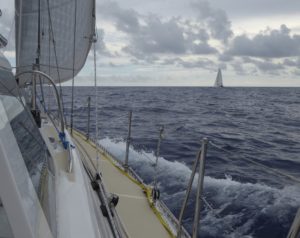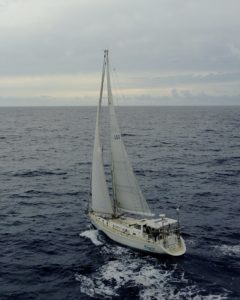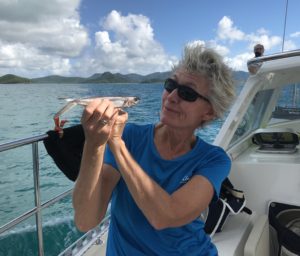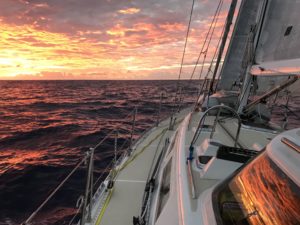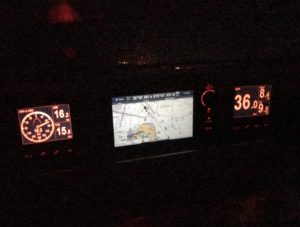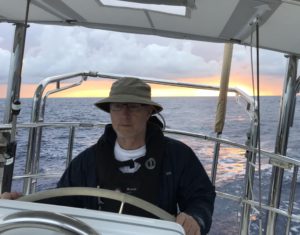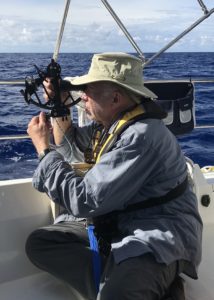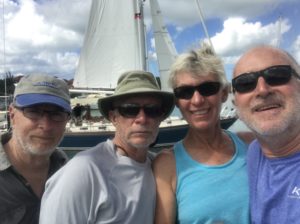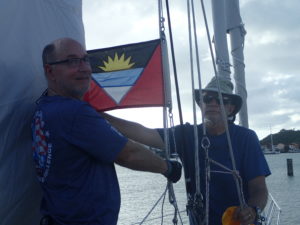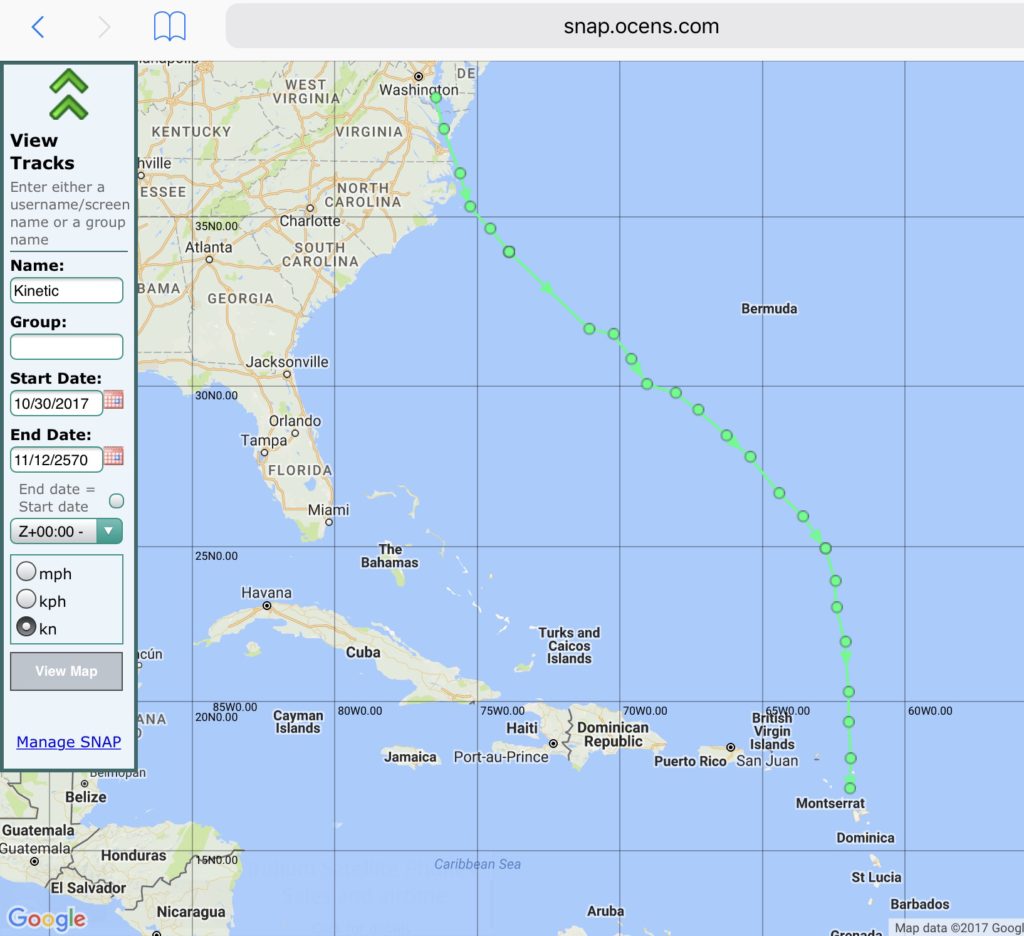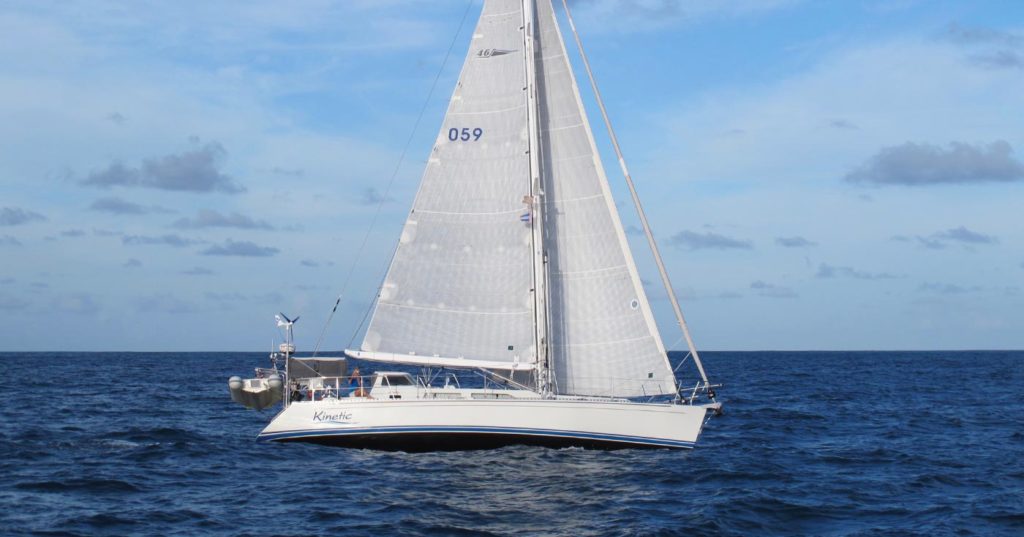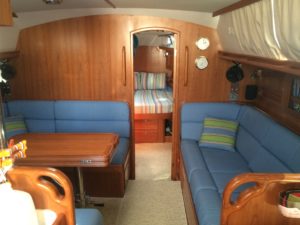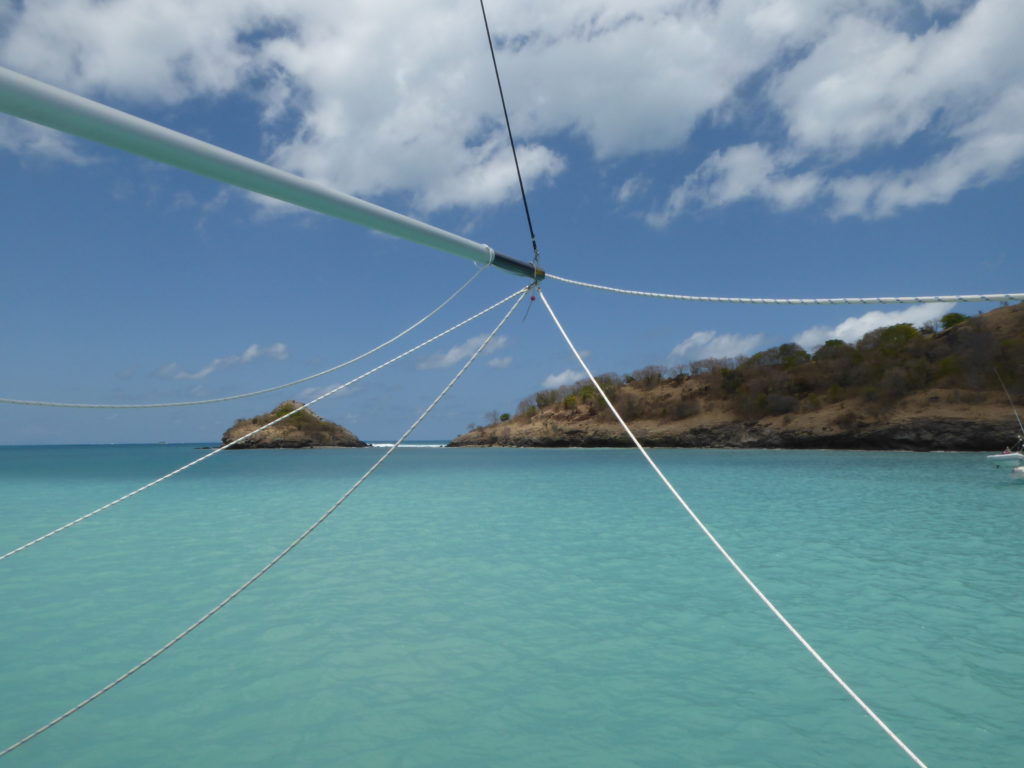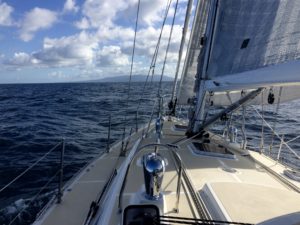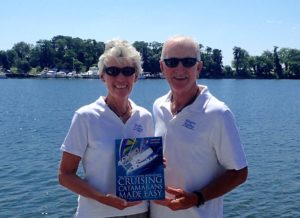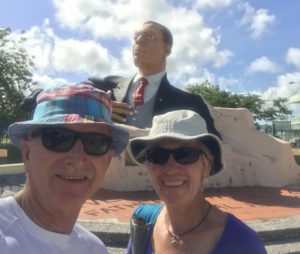
Visiting VC Bird in St Johns
After our passage, we spent 4 days in Jolly Harbour Marina, getting KINETIC (and ourselves) cleaned up and converted from passagemaking to cruising mode. Laundry done, the cold weather clothing and gear was packaged up and stowed away until our return passage. Our crew flew home to winter climes, but with the reassuring knowledge that they’d be back in January to sail with the Sail Solomons Antigua flotilla. Before moving out to the anchorage, we enjoyed a few happy hours and dinners with fellow passagemakers from GEMEAUX, PRATIQUE and WYNOT. Naturally, we took the local bus into St Johns to visit VC Bird’s memorial, the produce and fish markets, and Roti King.
While at JH, we spent many hours trying to get information on Barbuda, and how we might participate in relief efforts. While I got a few phone numbers of Barbudans, I was not able to connect with anyone, or find any substantive info on how we (or cruisers in general) could help. We found some very discouraging information that Barbudans were sheltered in the cricket stadium, and had little or no motivation to return and rebuild. We also were unable to determine how the seabed around Barbuda had changed – if Hurricane Irma breached the lagoon, it surely caused shoaling in other areas, and possibly moved some coral heads. We’re not quite ready to risk the keel in uncharted reef areas, so we’ll delay the Barbuda trip for now.
Deep Bay
From Jolly’s anchorage, we had a sweet downwind sail on the genoa to Deep Bay, a few miles north of Jolly on the west coast, at Antigua’s 10 o’clock position of Antigua (given Jolly Harbour at 9 o’clock). Deep Bay is one of our favorites – well sheltered, plenty of good anchorage space, sea turtles, an excellent beach, a fort to hike, and a wreck to snorkel. What more could you ask? We relaxed for 2 days here, enjoying our favorites and watching the Mystic Cruises catamarans take the day-charters to the beach.
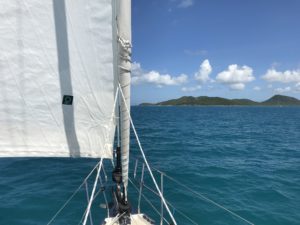
Sailing the leeward coast of Antigua
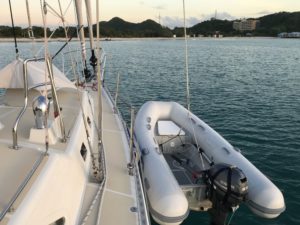
Set for the night, Deep Bay

Anchored in Deep Bay
North Sound
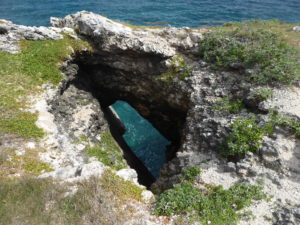
Blowhole on Great Bird Island
From Deep Bay, we sailed up the coast to the North Sound – a beautiful stretch of water between Antigua’s mainland and the outer reef. We sailed past the resort once known as Sunsail’s Club Colonna, where we ran a catamaran in 2008 for the American Sailing Association. The club closed for renovation later in 2008, and never re-opened; it’s now owned by an Italian company. Continuing on around Prickly Pear Island, we had a look at Jumby Bay on Long Island – an exclusive resort area where yachts can anchor, but are only welcome at the restaurant. Deciding this wasn’t for us, we continued onward to Great Bird Island (Antigua’s 3 o’clock position ) and dropped the anchor behind a few moored sailboats. What a find! A beautiful island with beaches on north and south sides, a ridge to hike (complete with blowholes), and a fantastic reef. We arrived on Sunday afternoon to find 3 small boats with local families on the North Beach – clearly this is a favored spot. Next day, several day-charter companies arrived to bring snorkelers out, and we had more insight on the best snorkeling sites – arrived at by dinghy. Andy brought his new drone ashore, and had a successful practice session launching, landing, and taking photos.
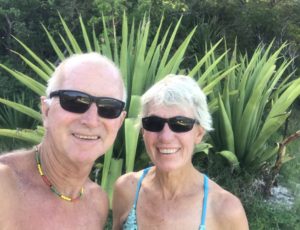
On Great Bird Island
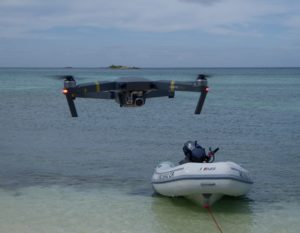
Andy’s drone “CRICKET” on her maiden flight
Green Island, Nonsuch Bay
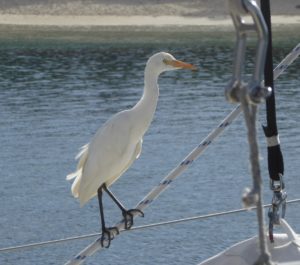
Visitor at Green Island
On Tuesday we motorsailed out through the reef at Horse Shoe Channel, and had a superb sail around to Green Island and Nonsuch Bay. Ricketts Harbour (locally known as Turtle Bay) has 2 mooring balls, and we were very happy to take one of them. Over the years, we’ve spent a fair bit of time in this omega-shaped cove, with snorkeling reefs bordering the sides, beach in the middle, and sea turtles in the seagrass below. Another favorite of day-charters with herds of snorkelers, but except for 1 other moored boat, we had a private cove by evening. We wanted to do something a little different for Thanksgiving, so we booked day passes at the Nonsuch Bay Resort, about 1.5 miles west on the bay. We spent a lovely day there, sailing the water toys all morning, having an excellent lunch on the Cliffside veranda, swimming in the infinity pools, and relaxing on the beach. The resort had good wifi, so I was able to call home and talk with family members who were all celebrating Thanksgiving in different ways.
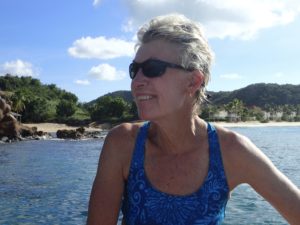
The dinghy sets you free!
Friday was a new adventure – Kitesurfing lessons! 40Knot operates a kitesurfing school at Green Island; last year we watched some fantastic foiling demos on the beach, and were inspired to learn. Andy and I booked the Beginner’s Camp half-day lesson. Our instructor Tyvon picked us up at KINETIC and took us to the beach, where we learned to launch, fly, land and maneuver the training kite. Easy, and lots of fun! Next step was to inflate the big kite, and head out to the water. We tied the dinghy onto a mooring ball and practiced while perched on the side of the dinghy, then Tyvon lowered us into the water to try the skills there. Unfortunately, the wind dropped so much that the kite wouldn’t fly, so the rest of our lesson was postponed until next day. Saturday dawned with heavy rains followed by light winds, but the wind filled in and we resumed our lesson. A bigger kite today, inflated at the beach and back again to the mooring ball. Everything was so much easier with sufficient wind – we practiced launching, landing and flying the kite at different positions – again while seated on the dinghy. I was first for the in-water practice, which was a blast. First was keeping the kite at the 12 o’clock neutral position, then moving it between 11 and 1 o’clock, the 12 and 2 o’clock. At some point, Tyvon untethered me from the dinghy, and I was drifting and “body dragging” downwind. As I steered the kite and applied various amounts of power, I was literally pulled out of the water to knee level, and unceremoniously dunked back in. Andy posted a video of this dunking performance, and my nephew commented that I looked like a teabag! Anyway, it was quite an experience… and we haven’t even got onto the board! That will be next lesson… ??
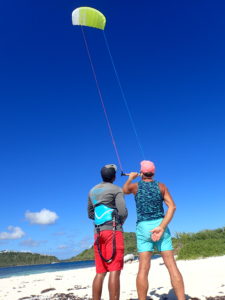
Andy practices with the training kite
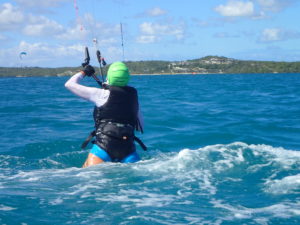
Lisa practices the “body drag”
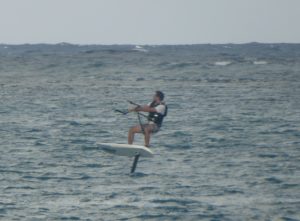
Maybe next lesson?!
Falmouth & English Harbour
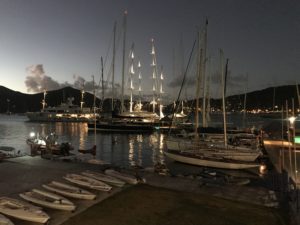
Falmouth by night
We arrived in Falmouth Harbour on Sunday afternoon, anchored off Pigeon Beach just in time to attend the Suzie Too beach BBQ, attended primarily by Salty Dawgs and OCC members. Great to meet hosts Suzie and David, whose boat was hauled out at Zahniser’s (our homeport marina in Solomons) for 6 months last summer. We caught up with a few cruising friends, and met several new ones. It was good to share cruising plans and local information, and we’ll no doubt meet up again with many of them down-island. Pigeon Beach is a local favorite – lots of families having BBQs, birthday parties, impromptu soccer matches, and swimming. We spent last Easter Sunday with the grandkids here, playing beach cricket after the onboard Easter hunt.
No visit is complete without a stroll through English Harbour, and the famous Nelson’s Dockyard. Classic yachts and Admiral Nelson’s history rule the day.
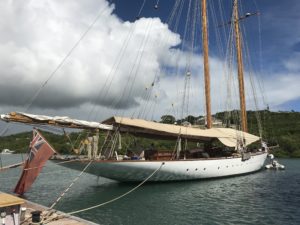
Classic yacht ELEANOR at the Dockyard, Clarence House on the hill
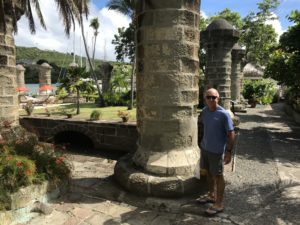
Georgian Pillars at Nelson’s Dockyard, English Harbour
 The watermaker testing was a little more tricky. We tested our new Rainman watermaker at our home before departure, but since we couldn’t test it in Chesapeake Bay water, we didn’t try it on the boat. We had already topped up with freshwater at Jolly Harbour, but wanted to ensure the Rainman worked “in situ” before heading down island. First attempt was Saturday morning at Green Island, while awaiting our kitesurfing lesson. The Rainman requires 110V AC power, so we fired up the generator, energized the outlets, and turned on the switch – only to find that it tripped the outlet or circuit breaker each time. We tried this on 2 different outlets/circuits with the same result. Reread the instructions, checked all the fittings… to no avail. Emails to the Rainman rep and the Outbound rep for ideas, as we didn’t know if the problem was with the Rainman, the boat, or the generator! Fast responses from each, so on Monday we packed the Rainman into the dinghy and took it ashore to test on a 110V outlet at the marina office – where it worked like a charm. OK, it’s not a Rainman issue. An electrician at the marina suggested we had the wrong type GCFI outlet, and needed a heavier duty one. He recommended the shop in St Johns, so Andy made plans to take the bus to St Johns. Back at the boat, Andy removed the outlet to match the size, and discovered that we DID already have the heavy duty type. One more thing to try…. the outlets on the port side, which run on a different circuit. Voila! With an extension cord to the galley outlet, the Rainman worked as advertised. We filled the tanks, washed down the boat, and advised Outbound – we still need to resolve the electrical issue, since the Rainman only fits in its starboard side compartment. Getting it reinstalled is another story… but it’s done. Luckily, we have big water tanks and are very conservative with freshwater.
The watermaker testing was a little more tricky. We tested our new Rainman watermaker at our home before departure, but since we couldn’t test it in Chesapeake Bay water, we didn’t try it on the boat. We had already topped up with freshwater at Jolly Harbour, but wanted to ensure the Rainman worked “in situ” before heading down island. First attempt was Saturday morning at Green Island, while awaiting our kitesurfing lesson. The Rainman requires 110V AC power, so we fired up the generator, energized the outlets, and turned on the switch – only to find that it tripped the outlet or circuit breaker each time. We tried this on 2 different outlets/circuits with the same result. Reread the instructions, checked all the fittings… to no avail. Emails to the Rainman rep and the Outbound rep for ideas, as we didn’t know if the problem was with the Rainman, the boat, or the generator! Fast responses from each, so on Monday we packed the Rainman into the dinghy and took it ashore to test on a 110V outlet at the marina office – where it worked like a charm. OK, it’s not a Rainman issue. An electrician at the marina suggested we had the wrong type GCFI outlet, and needed a heavier duty one. He recommended the shop in St Johns, so Andy made plans to take the bus to St Johns. Back at the boat, Andy removed the outlet to match the size, and discovered that we DID already have the heavy duty type. One more thing to try…. the outlets on the port side, which run on a different circuit. Voila! With an extension cord to the galley outlet, the Rainman worked as advertised. We filled the tanks, washed down the boat, and advised Outbound – we still need to resolve the electrical issue, since the Rainman only fits in its starboard side compartment. Getting it reinstalled is another story… but it’s done. Luckily, we have big water tanks and are very conservative with freshwater.